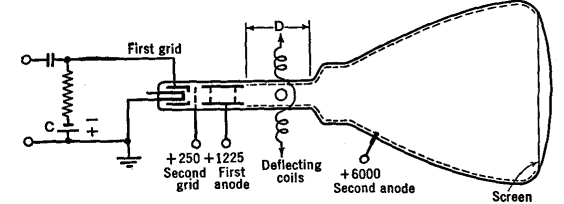Picture Tubes
Author: J.B. Hoag
Cathode-ray tubes are used in television receivers. A typical kinescope is shown in Fig. 21 L. The neck of the tube is kept narrow over the region D in order that magnetic deflecting coils can be mounted close to the beam.
 |
| Fig. 21 L. A kinescope (No. 1804) |
The glass envelope is then enlarged rapidly so that the electrons can be deflected over a large screen without striking the walls of the tube. The second anode consists of a conducting surface (sometimes " aquadag," a colloidal graphite deposit) extending over much of the inner surface of the tube, as indicated by the dotted lines in Fig. 21 L. This offers a field-free space and helps return the electrons from the screen. With high voltages on the second anode, the electrons strike the screen with considerable energy and produce a bright image. If the spot is not cut off by the C-battery, it must be kept in rapid motion or it will destroy the screen material. In some of the tubes, the electrons must pass through a very thin metallic coating deposited over the screen material. This coating assists them to return to the cathode. If a negative charge accumulates on the screen, it will serve to deflect away oncoming electrons, and distorted patterns result. Normally the tube is operated with a C-voltage as in Fig. 21 L, or with a cathode resistor, so that the first grid cuts off all electrons and the light does not appear on the screen. A positive signal applied to the first grid decreases its negativeness and allows electrons to proceed down the tube. The brightness of the light on the screen depends on the beam current (number of electrons per second which strike it). A plot of the beam current versus the control (first) grid voltage looks very much like the characteristic curve of a triode. The grid must not go positive or excessive currents will flow and the tube will be damaged.
|


 Electronic Devices
Electronic Devices  Cathode-Ray Tubes
Cathode-Ray Tubes  Picture Tubes
Picture Tubes





 Electronic Devices
Electronic Devices  Cathode-Ray Tubes
Cathode-Ray Tubes  Picture Tubes
Picture Tubes

